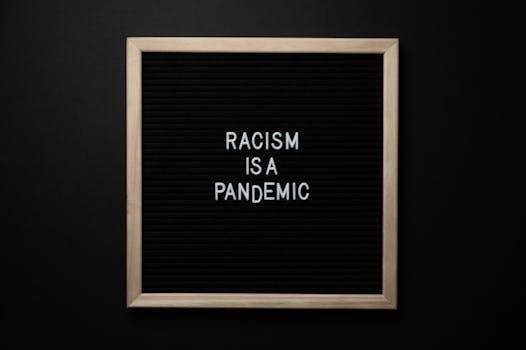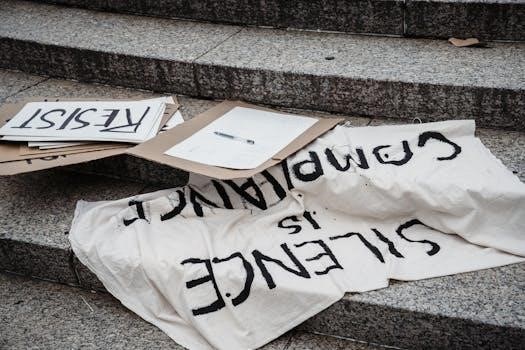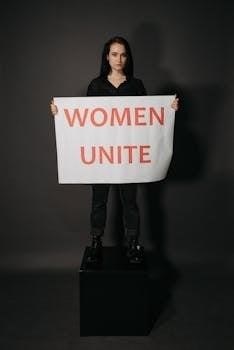Overview of “A Call for Unity”
The document‚ often referred to as “A Call for Unity‚” is a statement signed by eight Alabama clergymen. It was published in response to civil rights demonstrations in Birmingham and urged an end to protests. The letter also suggested that racial matters should be pursued in courts‚ not in the streets.
Background of the Document
“A Call for Unity” emerged from the racially charged environment of Birmingham‚ Alabama‚ in 1963. Prior to its publication‚ these same clergymen had issued “An Appeal for Law and Order and Common Sense” earlier that year‚ revealing a consistent stance against direct action protests. The document was a direct response to the increasing civil rights demonstrations led by Dr. Martin Luther King Jr.‚ and his supporters. These demonstrations were challenging the deeply entrenched segregationist policies of the South. The clergymen‚ while claiming to understand the desire for racial equality‚ expressed a belief that these demonstrations were counterproductive to achieving progress through legal and established channels. This context is crucial to understanding the motivations and underlying arguments presented in “A Call for Unity”. The letter sought to portray the clergymen as reasonable and moderate voices. They felt that their approach to resolving racial issues was more effective than direct action.
Authorship and Context
“A Call for Unity” was authored by eight clergymen from various religious denominations in Birmingham‚ Alabama. These individuals held positions of influence within their respective communities‚ giving their statement significant weight. Although they presented themselves as allies of the anti-racist cause‚ their views were ultimately more aligned with maintaining the status quo. They considered themselves moderate voices who were seeking a measured approach to racial integration. The context of the document’s publication is crucial to understanding its intent. It was released during a period of heightened racial tension in Birmingham‚ as civil rights activists were employing direct action tactics to challenge segregation. The clergymen’s response reveals a desire to control the narrative surrounding racial equality and to influence public opinion against the demonstrations‚ showcasing a preference for a slow progress rather than the rapid change advocated by the civil rights movement.

Rhetorical Analysis of “A Call for Unity”
The document employs various rhetorical strategies to persuade its audience. It uses appeals to authority‚ attempts to create a sense of shared values‚ and employs euphemisms to downplay racial injustice.
Use of Logos and Ethos
The authors of “A Call for Unity” strategically employ both logos and ethos to bolster their arguments. They attempt to establish their credibility (ethos) by presenting themselves as reasonable and responsible citizens‚ who have previously appealed for law and order. They convey a sense of shared understanding‚ suggesting they comprehend the complexities of racial issues. Their use of logic (logos) includes the assertion that legal avenues are the appropriate channels for addressing racial concerns‚ implying protests are counterproductive. They also use the logic that the demonstrations will disrupt the community and potentially derail any progress that has been made.
By presenting themselves as moderate voices seeking resolution‚ they attempt to gain the trust of a broad audience. The use of these appeals is a calculated attempt to present their perspective as the most sensible and reasoned. The clergymen emphasize their supposed understanding of the racial problems‚ which further enhances their credibility. They aim to come across as having carefully considered the situation‚ which serves to elevate their claims.
Appeals to Religious Authority
The clergymen who authored “A Call for Unity” heavily rely on appeals to religious authority to lend weight to their arguments. As religious leaders‚ their words carry an inherent moral and spiritual significance within the community. This appeal is evident in their implicit suggestion that their stance aligns with Christian principles of unity and order. The document’s title itself‚ “A Call for Unity‚” evokes a sense of religious harmony and togetherness. They implicitly position themselves as guardians of these principles.
They use the common ground of shared faith to encourage the Black community to comply with their requests. The clergymen use their position as pastors and rabbis to suggest that their perspective is in line with God’s wishes. This strategy is designed to tap into the religious convictions of the audience‚ hoping to persuade them through spiritual means. Their religious positions make the call for unity a moral imperative‚ not just a request. This appeal to faith is meant to dissuade the audience from supporting the civil rights movement.
Strategies to Preserve Status Quo
“A Call for Unity” employs several strategies aimed at preserving the existing racial hierarchy and social order. One of the key tactics is to frame the civil rights demonstrations as disruptive and harmful‚ suggesting that they are counterproductive to achieving racial progress. By emphasizing the need for “law and order” and “common sense‚” the authors aim to portray themselves as responsible arbiters of social stability‚ while casting the protestors as agitators. This portrayal serves to delegitimize the movement and discourage participation.
Additionally‚ the clergymen advocate for a gradual approach to racial equality‚ proposing that change should occur through established legal channels. This strategy appeals to those who fear rapid change and reinforces the idea that the current system is capable of addressing racial injustices. This approach effectively reinforces the existing power structures‚ urging for a slow progression that does not threaten the status quo. By promoting caution and condemning direct action‚ the document attempts to maintain the existing social and political landscape.

Response to “A Call for Unity”
The “Call for Unity” provoked significant responses‚ most notably from Martin Luther King Jr.‚ who addressed it in his famous “Letter from Birmingham Jail.” His response challenged the clergymen’s views and arguments.
Martin Luther King Jr.’s Response
Martin Luther King Jr.’s response to “A Call for Unity” is primarily encapsulated in his powerful “Letter from Birmingham Jail.” Written while incarcerated‚ King’s letter is a direct and detailed rebuttal to the clergymen’s appeal. He meticulously addresses their concerns about the timing and methods of the civil rights protests‚ arguing that they were necessary and justifiable responses to the systemic injustices faced by African Americans. King defends the use of nonviolent direct action as a means of creating tension and forcing negotiation‚ rather than waiting for a slow and often nonexistent legal process. He also criticizes the moderate stance of the clergymen‚ accusing them of being more concerned with order than with justice. King’s letter is a profound defense of the civil rights movement and a powerful call for action against racial inequality. He articulates the moral imperative to challenge unjust laws and practices‚ emphasizing the urgency of the struggle.
Impact on the Civil Rights Movement
The publication of “A Call for Unity” and the subsequent response‚ particularly Martin Luther King Jr.’s “Letter from Birmingham Jail‚” had a profound impact on the Civil Rights Movement. The clergymen’s statement‚ intended to quell protests‚ inadvertently galvanized the movement by highlighting the opposition it faced‚ even from those considered moderate. King’s eloquent and passionate letter became a foundational text for the movement‚ providing a powerful justification for nonviolent direct action and exposing the hypocrisy of those advocating for gradual change. It shifted the narrative‚ forcing the nation to confront the moral urgency of racial equality. The exchange between the clergymen and King sparked widespread discussion and debate‚ raising awareness of the movement’s goals and challenges. It also helped solidify support for civil rights among those who had been on the fence‚ contributing to the momentum that ultimately led to landmark legislation. The episode served as a crucial turning point‚ demonstrating the power of principled resistance and the importance of challenging unjust systems.

Key Themes and Implications
The document reveals a desire to maintain the existing social order. It also demonstrates a preference for slow‚ cautious progress‚ rather than immediate change. The letter ultimately serves as a condemnation of the Civil Rights Movement’s actions.
Condemnation of Civil Rights Movement
“A Call for Unity” is fundamentally critical of the Civil Rights Movement‚ specifically targeting the demonstrations and protests occurring in Birmingham. The clergymen express a strong disapproval of these actions‚ viewing them as disruptive and counterproductive to achieving racial harmony. They argue that such confrontational tactics‚ even if technically peaceful‚ incite hatred and violence. The letter suggests that the movement’s methods are ill-advised‚ potentially hindering progress by creating unnecessary tension. They feel that the protests impede the more measured legal processes for addressing racial issues. The clergymen imply that the activists are too impatient‚ not understanding that meaningful progress requires time and deliberation. The document portrays the movement’s leaders as outsiders who are stirring up trouble in the community. It paints a picture of a community that was largely harmonious before the civil rights demonstrations‚ suggesting that these protests are the primary cause of racial division.

Call for Caution and Slow Progress
The authors of “A Call for Unity” advocate for a cautious and gradual approach to addressing racial issues. They express their belief that meaningful change should come through established legal channels and not through disruptive street protests. The clergymen imply that the civil rights movement’s demands are too hasty‚ suggesting that a more measured and deliberate pace is necessary for sustainable progress. They urge the black community to be patient‚ emphasizing that their hopes will be realized more effectively through a slow‚ deliberate process. The letter conveys a sense of discomfort with the urgency of the movement‚ suggesting that the activists’ methods are not only disruptive‚ but also counterproductive in the long run. The clergymen suggest that the movement’s actions risk setting back legal efforts to reach a racial compromise. They believe that the social fabric should be preserved‚ and such changes must happen gradually to avoid major societal disruptions.
Preservation of the Status Quo
“A Call for Unity” can be interpreted as a document aimed at preserving the existing social order. The clergymen’s call for an end to protests and a preference for legal channels effectively seeks to maintain the established power structures. By urging caution and slow progress‚ the authors are‚ in essence‚ attempting to delay the rapid changes sought by the civil rights movement. The letter’s emphasis on law and order‚ and its disapproval of disruptive demonstrations‚ reinforces the status quo‚ which favored the white population. The document suggests that the existing system‚ while perhaps not perfect‚ should not be challenged so directly. The clergymen’s call for unity seems to be aimed at maintaining the existing racial hierarchy rather than truly creating equality. Their rhetoric serves to discourage activism and promotes acceptance of the current conditions‚ thus reinforcing the status quo. The letter implies that change should be gradual and controlled‚ avoiding any radical restructuring of society.




